Intro
- Intro
- Quality
- Samples
- Verdict
The Nikkor AF-S 28mm f/1.8G is a wide angle lens designed for Nikon’s range of DX and full-frame FX-format DSLRs. Announced April 2012, it’s the larger aperture sibling to the venerable Nikkor AF 28mm f2.8D from 1994. It can also be considered a cheaper alternative to the AF-S 24mm f/1.4G and AF-S 35mm f/1.4G (see my Nikon 35mm f1.4G review for the performance of this high-end model).
With a line-up of three not too expensive f1.8 primes at 28mm, 50mm, and 85mm, Nikon seems to have completed the renovation of a set of FX-capable lenses that are considered the primary goal for people wanting large aperture primes at a reasonable price.
The 28mm focal length sits nicely in-between 24mm and 35mm as you can see in the following image where I’ve inserted the frames for the respective focal lengths. Thus an 28mm lens might be considered a more attractive complement to a 50mm prime than both the slightly wider and longer alternatives. 28mm offers a clearly wider angle of view: it captures around 56% more area of any given scene than a 35mm lens. Which also might be considered too close to the framing of a 50mm lens to be of interest to owners of the latter. But conversely a focal length of 28mm on an FX-body is not as “extreme” as a 24mm. Distortions at the borders of the frame are less pronounced and thus more acceptable. Meanwhile on a DX-body a 28mm lens is equivalent to 42mm and considered close to the ideal focal length that matches the diagonal of the sensor and thus produces “normal” looking images.
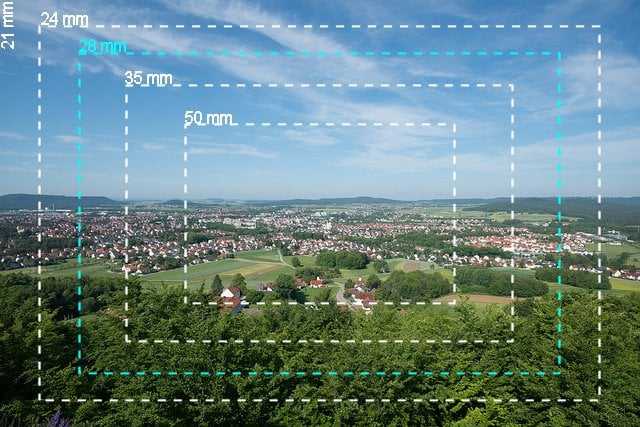 |
Interestingly Nikon has so far chosen not to produce an AF-S 24mm f/1.8G or an AF-S 35mm f/1.8G for the FX full-frame format (although of course there is the popular DX 35mm f/1.8G lens for cropped bodies). That may have to do with economical reasons, but Nikon might have fared better had it given its DX 35/1.8G a proper FX image circle and complemented it with a 24/1.8G, because a 28mm prime might just be too long for some and too short for others. But again, such a move might have brought the risk of jeopardizing sales of its 24/1.4G and 35/1.4G lenses.
So far Nikon’s new f1.8 designs (the 50/1.8G and the 85/1.8G) have proven to be sharp and contrasty rendering neutral colors (see my Nikon 50mm f1.8G review and Nikon 85mm f1.8G review). This puts pretty high expectations on the newcomer. In this review I’ll have a look at Nikon’s newest 28mm f1.8G prime, and find out whether the lens lives up to the expectations.
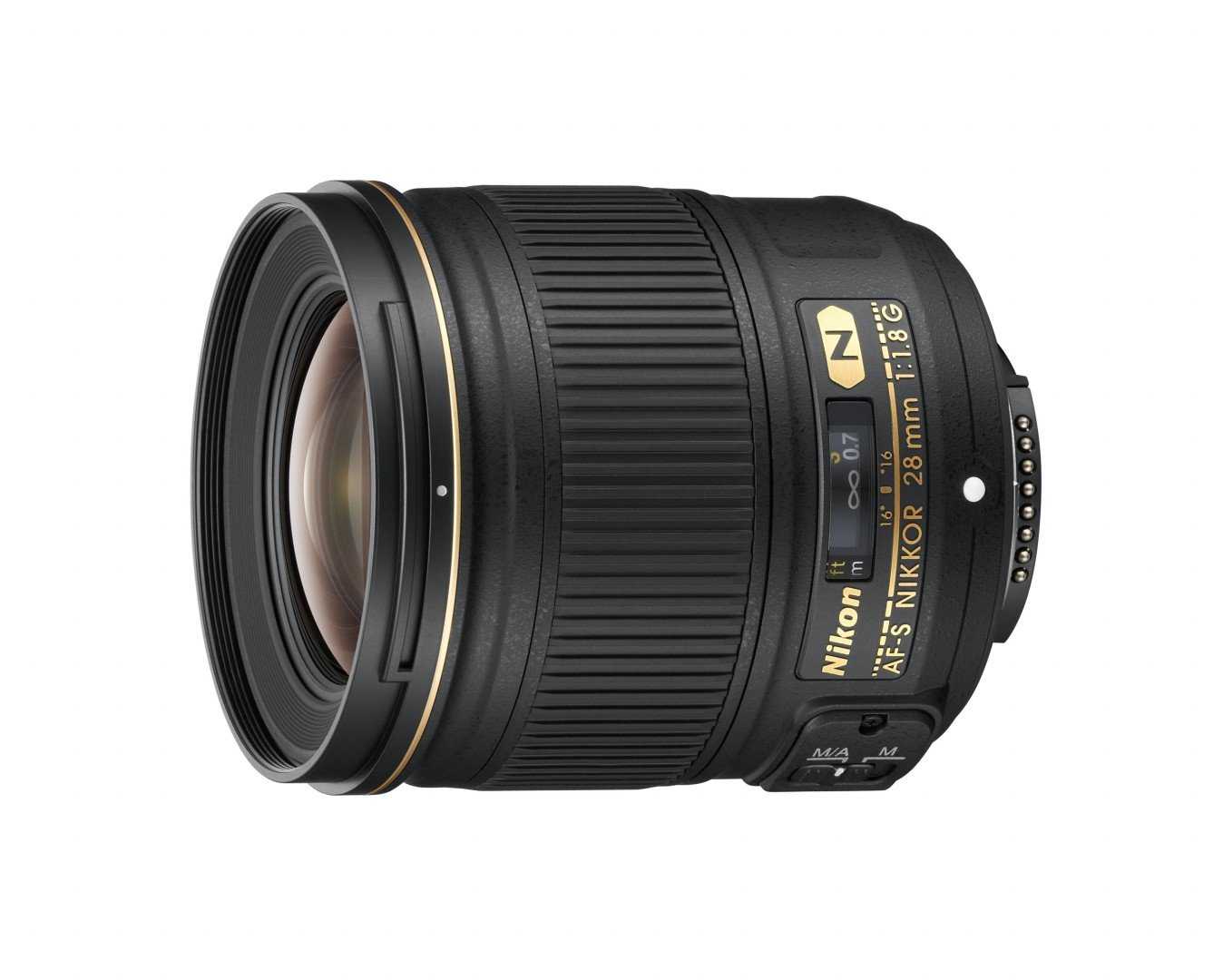
Facts from the catalog
As usual I’ll have a look at the technical data first. I’ve rated the features with a (or ), when it’s better than average or even state of the art, a if it’s standard or just average, and if there’s a disadvantage.
Size (diam. x length): 73 x 81 mm (2.9 x 3.2 in.). It’s slim but pretty long – especially compared to the Nikon 28/2.8D at only 45 mm (1.8 in.) length
Weight: 330 g (11.6 oz) = pretty light-weight, although the 28/2.8D is only 205 g (7.2 oz.). But the lenses from Sigma and Zeiss are both much heavier at around 500 g.
Optics: 11 elements in 9 groups. More than the 28/2.8D with 6 lenses in 6 groups but still only a small amount of glass compared to zooms that tend to have something like 21/16. That bodes well for contrast and flare-resistance. Plus Nikon used Nano-coating on this lens and the cross-section does show two aspherical elements.
Closest focus distance/max. magnification: 0.25 m (0.82 ft.) / 1:4.5. This is close to what I often need in nature (1:3-1:5).
Filter-thread: 67mm = a cheaper standard than with the larger pro-lenses
IS: No = not really critical at such a short focal length, although Nikon’s own 24-120/4.0 has VR
AF: AF-S with SWM (silent wave motor), so does work on D60/3×00/5×00-bodies, and there’s manual-focus override by turning the focus ring
Covers full frame/FX or smaller = very good
Price: around 700 EUR new (incl. 19% VAT) = not cheap! The old Nikon AF 28/2.8D is around 280 EUR now, the Sigma AF 28mm 1.8 EX DG Asp Macro can be had for 430 EUR and only the manual focus Zeiss ZF.2 Distagon T* 28mm 2.0 is more expensive at over 1000 EUR.
Comes with a flexible lens pouch, lens-shade is included and revertible for transport, and the lens-caps are standard Nikon’s.
Distance information is relayed to the camera, so the Nikon body can do all the advanced exposure-related stuff with this lens. But this is true for most alternatives too.
Aperture ring = no, just like all Nikon G-lenses.
Sealing: yes! A rubber grommet at the lens-mount.
So the score in the “features-department” is 0/6/7. This lens ticks almost all important boxes, except perhaps a price below 500 EUR.
Тема: Nikkor 28mm f/1.8g af-s — все об объективе, примеры фотографий, впечатления, советы
Автор реплики: Alsie
Купил недавно этот объектив пока на кроп, на замену 35 1,8 G. Нравится, очень резкий,кажется есть «картинка».Для меня 28 мм стало поудобнее 35 мм в качестве штатника, да и в квартире больше «развернешься».Когда брал у знакомого этот объектив поснимать,сделал мало кадров(всего 4-5). Забыл об этом, а через недельку сбрасывал с карты памяти в компьютер большое количество «отпускных» фотографий,стал их рассматривать и глаз сам остановился на кадрах,сделанных на 28 G, так они отличались от сделанных на 16-85 своей картинкой. (в лучшую сторону).
Автор реплики: Bomzel
все же 16-35/4 совсем другой объектив. 28 хорош тем, что он а) легок, б) светел, в) относительно дешев. если бы были деньги изначально — я бы — в силу перфекционизма — брал бы 24/1.4. но, являясь владельцем 28-го — понимаю — что мне его хватает. Я 98% снимаю для себя — и на 100% он меня удовлетворяет. 2% снимаю за деньги — и он меня на 100% удовлетворяет. разница в деньгах между 24 и 28 — в принципе — не такая уж и глобальная. потому что, покупая объектив за 20000 — мы морально готовы купить и за 40000 стекло. надо полагать, что аргументами при выборе будут служить: платежеспособность, некий снобизм и уверенность в том, что рисунок 24 лучше, чем у 28.
Автор реплики: Alex_Ross
как бывший владелец 30 ки и нынешний 28-шки посоветую раскошелится на Sigma 35 Art.
На кропе 28 весьма посредственный на открытой вплоть до f/2,8, даже по сравнению с 30 кой, не говоря уж 35 ке. На фф веселее, что хорошо видно по этой ветке.
 
 
First Look
First of all, this is a lightweight and ultra fast lens with Nano Crystal Coating. Nikon has recently started to produce affordable prime lenses with Nano Crystal Coating, like the Nikon 20mm f/1.8G ED and Nikon 24mm f/1.8G ED. Nano Crystal Coating is a technology usually used on high-end lenses by Nikon which prevents reflections inside the glass elements, and as a result, it increases the clarity and sharpness on images while preventing the unwanted reflections, flares, and ghosting. Therefore it makes a lens better in quality.
Also, it’s just 330 grams in weight and it makes this lens easy to carry around, even with big full frame DSLR bodies. By the way, 28mm is the focal length that most of you are already familiar with it, as many smartphone cameras have this same focal length. So, before setting up your camera and tripod, you always have a chance to check your frame with your smartphone.
Another advantage of this lens is its relatively small filter thread size of 67mm. It has the same filter thread size as the Nikon 85mm f/1.8G, and if you own both lenses in your gear bag then you can use the same filters for both lenses.

Nikon D810, 1/25 s at f/1.8, ISO 320
Sample Images
The thumbnails below link to full-sized samples taken with the AF-S Nikkor 28mm f1.8G ED lens mounted to a Nikon D3S.
Download
1/160s · f/1.8 · ISO 200 28mm (35mm)
Download Original
Download
1/125s · f/2 · ISO 200 28mm (35mm)
Download Original
Download
1/80s · f/2.8 · ISO 200 28mm (35mm)
Download Original
Download
1/40s · f/4 · ISO 200 28mm (35mm)
Download Original
Download
1/20s · f/5.6 · ISO 200 28mm (35mm)
Download Original
Download
1/10s · f/8 · ISO 200 28mm (35mm)
Download Original
Download
1/5s · f/11 · ISO 200 28mm (35mm)
Download Original
Download
1/3s · f/16 · ISO 200 28mm (35mm)
Download Original
Download
1/200s · f/1.8 · ISO 200 28mm (35mm)
Download Original
Download
1/100s · f/1.8 · ISO 200 28mm (35mm)
Download Original
Download
1/80s · f/1.8 · ISO 200 28mm (35mm)
Download Original
Download
1/25s · f/8 · ISO 200 28mm (35mm)
Download Original
Download
1/800s · f/8 · ISO 200 28mm (35mm)
Download Original
Download
1/30s · f/16 · ISO 200 28mm (35mm)
Download Original
Download
1/200s · f/1.8 · ISO 200 28mm (35mm)
Download Original
Download
1/320s · f/1.8 · ISO 200 28mm (35mm)
Download Original
Download
1/50s · f/8 · ISO 200 28mm (35mm)
Download Original
Download
1/1600s · f/2.8 · ISO 200 28mm (35mm)
Download Original
Download
1/80s · f/8 · ISO 200 28mm (35mm)
Download Original
Download
1/320s · f/8 · ISO 200 28mm (35mm)
Download Original
Download
1/5000s · f/1.8 · ISO 200 28mm (35mm)
Download Original
Download
1/2500s · f/2.8 · ISO 200 28mm (35mm)
Download Original
Download
1/320s · f/5.6 · ISO 200 28mm (35mm)
Download Original
Download
1/125s · f/16 · ISO 200 28mm (35mm)
Download Original
Download
1/1250s · f/5.6 · ISO 200 28mm (35mm)
Download Original
Download
1/160s · f/8 · ISO 200 28mm (35mm)
Download Original
Download
1/640s · f/8 · ISO 200 28mm (35mm)
Download Original
Download
1/500s · f/8 · ISO 200 28mm (35mm)
Download Original
Download
1/2000s · f/1.8 · ISO 200 28mm (35mm)
Download Original
Download
1/160s · f/11 · ISO 200 28mm (35mm)
Download Original
Download
1/125s · f/11 · ISO 200 28mm (35mm)
Download Original
Download
1/200s · f/4 · ISO 200 28mm (35mm)
Download Original
Download
1/40s · f/4 · ISO 200 28mm (35mm)
Download Original
Download
1/125s · f/11 · ISO 200 28mm (35mm)
Download Original
Download
1/15s · f/2.8 · ISO 200 28mm (35mm)
Download Original
Download
1/100s · f/2.8 · ISO 200 28mm (35mm)
Download Original
Previous Page
« Sharpness: 1
Next Page
Lens Specs »
- Ease of Use
- Sharpness: 1
- Sample Images
- Lens Specs
- Rating & Conclusion
- Review Roundup
Ease of Use
 The Nikon 28mm f1.8G lens
The Nikon 28mm f1.8G lens
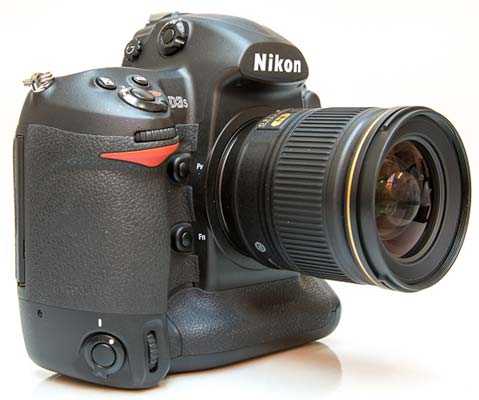 The Nikon 28mm f1.8G lens, isometric view
The Nikon 28mm f1.8G lens, isometric view
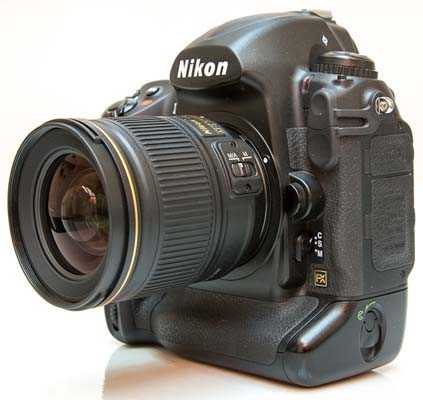 The Nikon 28mm f1.8G lens, isometric view
The Nikon 28mm f1.8G lens, isometric view
For a short prime, the Nikon AF-S Nikkor 28mm f/1.8G is a rather big lens., although not too heavy at 330g. While you can use it on a smaller DX body for a 42mm equivalent angle of view, it won’t balance well — as demonstrated by the images above, it’s a much better match for a professional-grade, full-frame like the D3S.
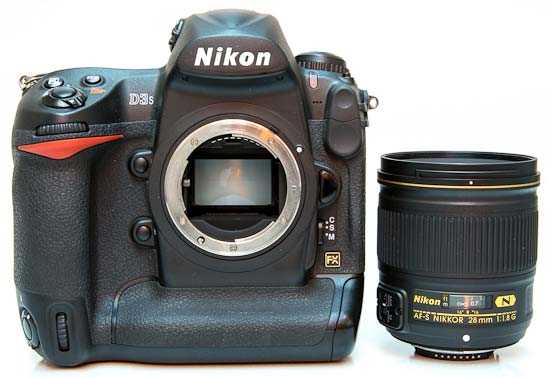 The Nikon 28mm f1.8G lens alongside the D3S
The Nikon 28mm f1.8G lens alongside the D3S
As you would expect from a lens that costs this much, build quality is very good. The Nikon 28mm f1.8G feels solid in your hand, even if the outer barrel and the filter thread appear to be made from plastic. The focusing ring is just as wide as it needs to be, and has a ridged, rubberised grip band. As this is a G series lens, it has no aperture ring — no big deal unless you wanted to use it on a very old film body.
 Front of the Nikon 28mm f1.8G lens
Front of the Nikon 28mm f1.8G lens
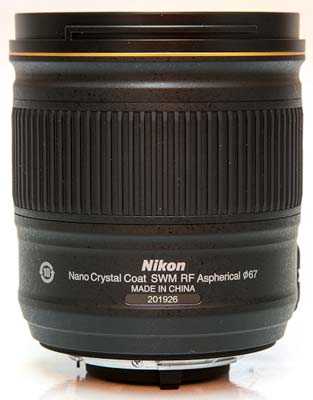 Rear of the Nikon 28mm f1.8G lens
Rear of the Nikon 28mm f1.8G lens
The lens features a distance scale complete with a DOF scale, although the latter is of limited use, having markings for f/16 only. Left of the focus index is a small dot that appears to be an infrared focus index.
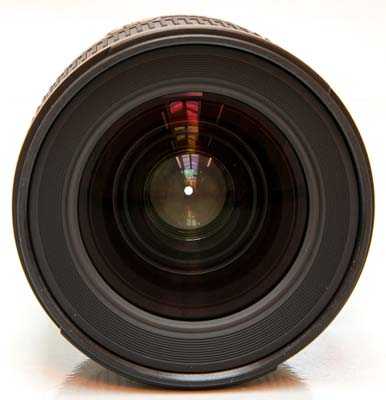 Front of the Nikon 28mm f1.8G lens
Front of the Nikon 28mm f1.8G lens
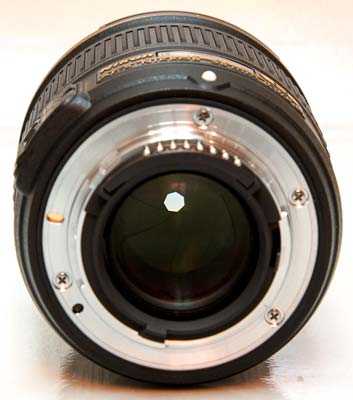 Front of the Nikon 28mm f1.8G lens. Note the rubber seal around the lens mount.
Front of the Nikon 28mm f1.8G lens. Note the rubber seal around the lens mount.
Since the Nikkor 28mm f/1.8 does not have Vibration Reduction, the only control on the lens barrel is a focus mode switch with the usual M/A and M settings.
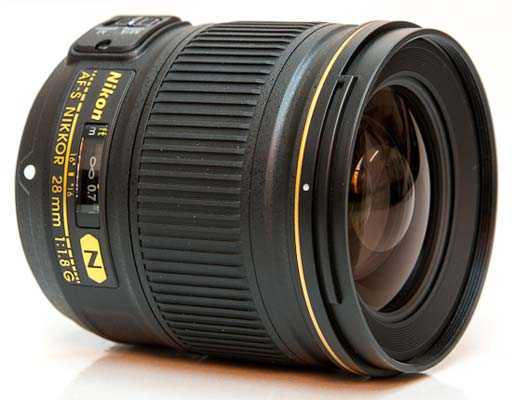 Front of the Nikon 28mm f1.8G lens
Front of the Nikon 28mm f1.8G lens
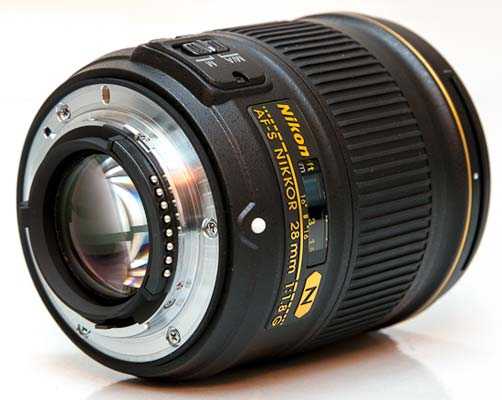 Rear of the Nikon 28mm f1.8G lens
Rear of the Nikon 28mm f1.8G lens
The Nikon AF-S 28mm f/1.8G is sealed against dust and moisture, so it’s a great companion for similarly sealed bodies even when they are used in dusty locales or less-than-ideal weather conditions.
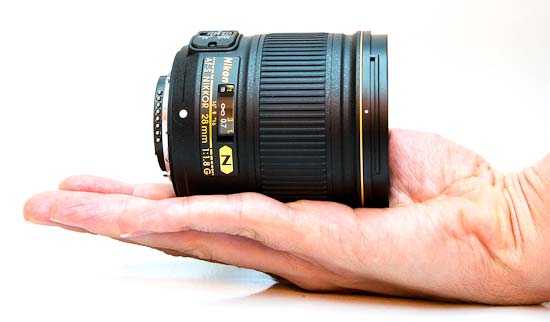 The Nikon 28mm f1.8G lens in-hand
The Nikon 28mm f1.8G lens in-hand
The lens ships with the dedicated HB-64 lens hood, which helps to reduce unwanted flare and to protect the front element from damage.
 The Nikon 28mm f1.8G lens with the HB-64 lens hood fitted
The Nikon 28mm f1.8G lens with the HB-64 lens hood fitted
Auto-focus
The Nikon 28mm f1.8 features a Silent Wave Motor (SWM) that allows near-silent auto-focusing on all Nikon DSLRs. Importantly, this solution allows instant manual override even when the focus mode switch is in the M/A position. Focusing is fully internal, meaning the length of the lens always remains constant. In use, we found the focusing to be indeed very quiet, and pretty fast — but definitely not instantaneous — with the lens mounted to a Nikon D3S body.
Chromatic Aberrations
Chromatic aberrations, typically seen as purple or blue fringes along contrasty edges, are impressively well controlled with this lens — the example below shows the worst-case scenario.
Light Fall-off
With the lens wide open at f/1.8, you can see some very noticeable light fall-off in the corners. Stopping down helps, although to completely get rid of this phenomenon, you will need to use an f-stop of f/5.6 or smaller.
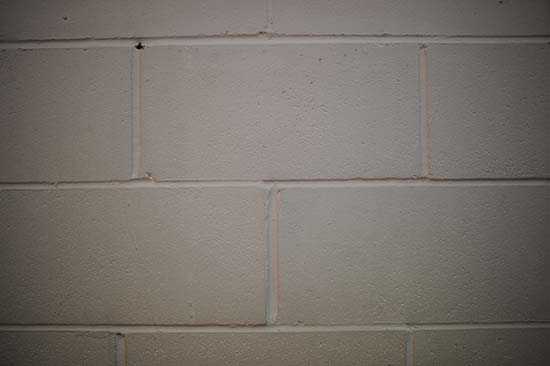
Macro
The Nikon 28mm f1.8 is not a macro lens. The close-focus point is at 25cm from the film/sensor plane, and Nikon quotes a maximum reproduction ratio of 0.22x for the lens. The following example illustrates how close you can get to the subject, in this case a CompactFlash card.
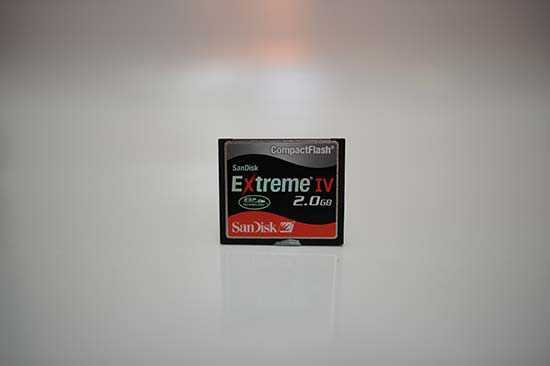 Close-up performance
Close-up performance
Bokeh Examples
Bokeh is a word used for the out-of-focus areas of a photograph, and is usually described in qualitative terms, such as smooth / creamy / harsh etc. One of the reason to buy a fast lens is to be able to isolate the subject from the background, which is normally very hard to do with an ultrawide lens. Nikon was apparently very much aware of this requirement, as they employed an iris diaphragm with 7 rounded blades for a pleasing rendering of the out-of-focus highlights. Based on what we have seen, we can say that they largely succeeded. Below you’ll find some examples, but you are also encouraged to check out our sample images.
Sharpness
In order to show you how sharp this lens is, we are providing 100% crops on the following page.
- Ease of Use
- Sharpness: 1
- Sample Images
- Lens Specs
- Rating & Conclusion
- Review Roundup
Tamron SP AF Aspherical Di LD [IF] 17-35mm F/2.8-4 A05. Обзор от читателя Радоживы
Вид объектива Tamron SP AF Aspherical Di LD 17-35mm F/2.8-4 A05, примеры фотографий с него, и сам обзор специально для Радоживы, подготовил Павел Тихий.
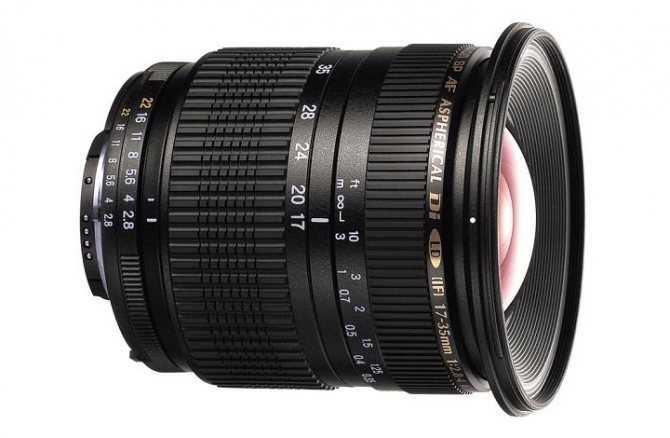
Tamron SP AF Aspherical Di LD 17-35mm F/2.8-4 A05
Tamron SP AF 17-35mm F/2.8-4 Di LD Aspherical — профессиональный суперширокоугольный автофокусный зум-объектив, выпускался для разных систем, в данном обзоре представлена модель для NIKON.
Фокусное растояние — 17мм-35мм Максимальная диафрагма — F2.8-F4 Минимальная диафрагма — F22-F32 Лепестков в диафрагме — 7 МДФ — 30см. Диаметр под светофильтры — 77мм. Вес объектива — 440гр.(!)
SP (Super Perfomance) в названии указывает на то, что объектив относится к профессиональным линейке. Di — Указывает на то что объектив будет прекрасно работать как на кропе так и на полном кадре. LD — (Low Dispersion) — объектив с использованием элементов из низко дисперсионного стекла (для подавления хроматических аберраций). IF — (Internal Focus) — У объектива внутренняя фокусировка, а это значит что он без проблем будет работать с светофильтрами.
В оптическую схему входят 14 элементов, из которых 1 LD (низкодисперсионное) и 3 AD (асферические) стекла, на деле это означает что уровень хроматических аберраций сведен к минимуму.
Made in Japan. Объектив собран очень добротно, метал и стекло — ничего лишнего. Никаких люфтов, резинки не растянуты, ход колец ОЧЕНЬ плавный. Объектив очень легкий и удобный в обращении. Кольцо управление диафрагмой расположено вплотную к байонету камеры и автоматически фиксируется кнопкой на значении F/22. На объективе имеется шкала дистанции фокусировки в метрах и футах. К объективу прилагается бленда, которую можно одеть задом на перед и без проблем пользоваться объективом.
Фокусировка у объектива быстрая, при достаточном освещении и даже когда солнце в кадре фокусируется цепко,в темноте фокусируется не так уверенно, но все в пределах нормы. Объектив не имеет мотора фокусировки и будет работать только на камерах с встроенным мотором фокусировки.
Качество изображения хорошее, объектив очень хорошо себя проявляет в боковом свете, но всетаки если загнать в кадр солнце то блик обеспечен, практически отсутствуют. Детализация не плохая с F/2.8, но только по центру, края все таки ощутимо проседают и особенно по углам, даже на прикрытых диафрагмах и на 17мм фокусного расстояния. Дисторсия обычная для такого рода объективов и легко правится при пост обработке.
Исходники с Nikon D600 можно посмотреть здесь.
Мой опыт
Для пейзажа, я бы не стал приобретать данный объектив из-за сомнительной резкости. Практически каждый день я использую данный объектив для съемки людей в закрытых помещениях (детские праздники, выкуп невесты, банкет), для этих целей он подходит как нельзя лучше. Мне очень нравится что он легкий и надежный (в отличие от моего предыдущего Tamron AF 17-50mm f/2.8 SP XR Di II LD Aspherical VC, который сыпался на глазах, из магазина). Также я сравнивал его с Nikon 17-35mm f/2.8D ED AF-S SWM IF Nikkor, Nikon «тянет» края так же, ход кольца зума был очень тугой (время берет свое), и намного тяжелее. По краям Nikonn не так мылит и постоянная светосила f/2.8, не убедили меня отдать за него 750$!. И, в итоге, в дополнение к tamron я взял Nikon 28mm f/1.8G N AF-S Nikkor за 310$.
P.S. Огромная благодарность Аркадию за его проект, успехов и процветания!
Тема: AF-S NIKKOR 28 мм f/1,8G
Автор реплики: Alex79
специфика 28 1.8 если верить фотозоне и другим обзорам в том, что данная линза имеет ярко выраженный провал в резкости за пределами центра, т.е. очень резкий центр- провал- сравнительно резкий край. на кропе это локальное падение резкости приходится как раз рядом с границей кадра. Поэтому именно с этой линзой фото кропа и фулфрейма покажут весьма различную картинку.
другими особенностями данной линзы считаются
— проблема сдвига фокуса
— невысокое качество сборки и применяемых материалов
— 7 лепестковая диафрагма
ее «старшая сестра» ни одной из выше перечисленных проблем не имеет, но стоит …
Автор реплики: Alexmen-76
Приобрел данный объектив на кроп (D7000). Первое впечатление — отличный штатник для меня: можно снимать пейзажи (по краям не мыльный,хорошая геометрия,контраст и цвет, также резок на прикрытых диафрагмах), удобен для съемки детей, предметов, можно даже портреты (поясные) попробовать поснимать. Пока у нас морозы,поэтому нет возможности полноценно его опробовать,но на холоде (-25 градусов) пашет.
Автор реплики: exploit
Опробовал объектив на свадьбе (примерно половина от всех кадров) стекло отработало просто прекрасно. Я очень доволен. Отличный цвет выдает, очень мягкое боке, даже сразу и не скажешь что 28мм, искажения минимальны. Картинка с этого стекла очень радует глаз. Считаю этот объектив отличной заменой одновременно 24/1.4 и 35/1.4 и проиграет он по сути только в светосиле немного, а на сэкономленные средства можно купить пару тушек D600
NIKKOR Z 28 мм f/2,8 (SE)
Мастер снимков.
NIKKOR Z 28 мм f/2,8 (SE)
Street smart.Классический вид.
Представляем специальную серию 28-мм объектива с классическим дизайном. Один из самых маленьких и легких фикс-объективов формата Full-frame/FX в системе Z. Получите превосходное качество изображения с уличной перспективой 28 мм — 42 мм на камерах формата APS-C/DX (эквивалент 35 мм) и быстрой максимальной диафрагмой f/2,8.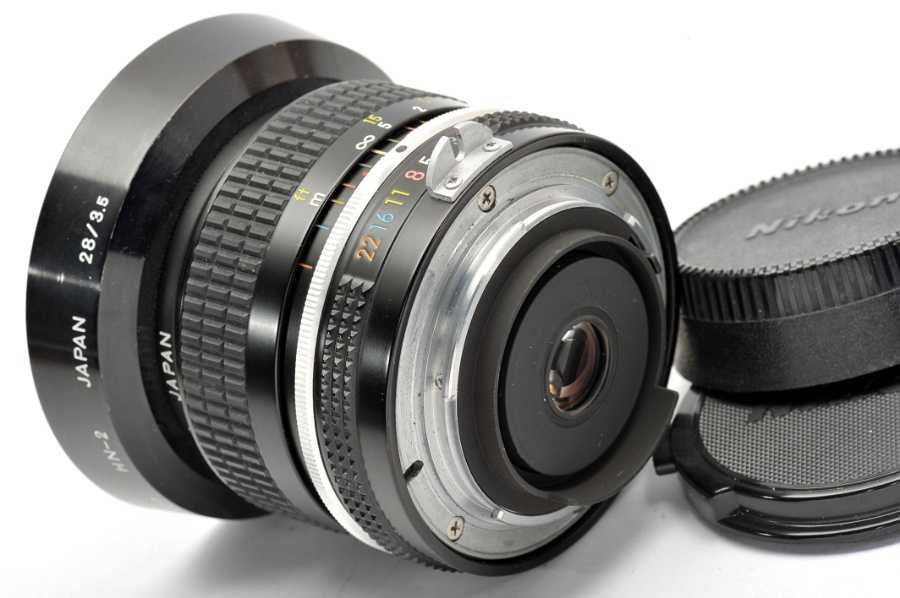 Это объектив для спонтанности.
Это объектив для спонтанности.
Универсальная чувствительность.
На камерах Z с матрицей APS-C, таких как Z fc или Z 50, объектив NIKKOR Z 28 мм f/2,8 (SE) работает как 42 мм (эквивалент 35 мм). Это отличный универсальный вид для видео, снимков, портретов — практически для чего угодно. На полнокадровой Z-камере он обеспечивает классический 28-миллиметровый угол обзора, который лучше всего подходит для уличной фотографии, архитектуры, интерьеров и ситуационных портретов.
Специальный дизайн.
NIKKOR Z 28 мм f/2,8 (SE) — отсылка к объективам Nikon 80-х годов — придает любой камере серии Z нотку классического стиля. Уникальная насечка на кольце управления основана на дизайнерских чертежах Nikon того периода — прекрасное сочетание формы и функциональности. Шрифт и логотип NIKKOR перекликаются с эпохой, дополняя классический вид.
Ничто не отягощает вас.
Объектив NIKKOR Z 28 мм f/2,8 (SE) настолько компактен и легок, что вы даже забудете о нем.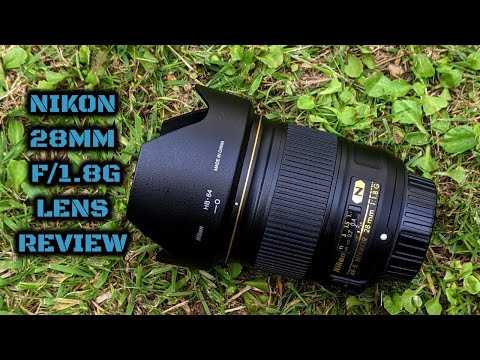 Классический компактный прайм, он не выдвигается и не убирается, поэтому он всегда готов. Берите его с собой, куда бы вы ни отправились, в качестве основного объектива для прогулок или легкого второго объектива.
Классический компактный прайм, он не выдвигается и не убирается, поэтому он всегда готов. Берите его с собой, куда бы вы ни отправились, в качестве основного объектива для прогулок или легкого второго объектива.
Подойдите поближе.
Объектив NIKKOR Z 28 мм f/2,8 (SE) с малым расстоянием фокусировки 0,63 фута (0,19 м) вознаграждает вас за приближение к объекту. Широкая перспектива и большая глубина резкости позволяют включать больше справочной информации в видео и фотографии.
Стреляйте в нерабочее время.
Большой байонет Z обеспечивает еще большую производительность при слабом освещении благодаря широкой диафрагме f/2,8. Запечатлейте настроение при слабом освещении с ясностью и резкостью.
Разбираетесь в видео.
Классический 28-мм объектив — выдающийся видеообъектив. Объектив NIKKOR Z 28 мм f/2,8 (SE) значительно подавляет «дышание» фокусировки, чтобы предотвратить смещение угла обзора во время записи. Выполните плавную регулировку диафрагмы, создающую естественный сдвиг яркости.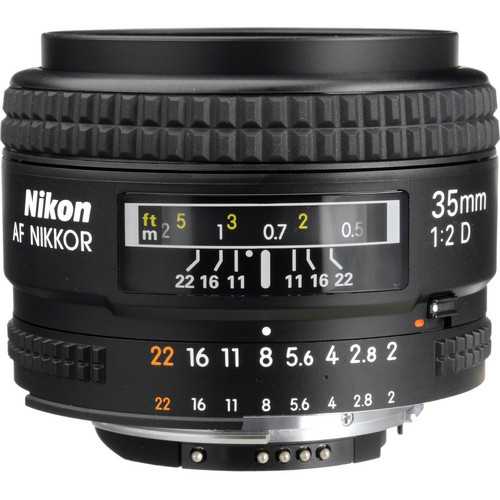 И все это время двойные шаговые двигатели работают почти бесшумно, чтобы сохранить целостность звука.
И все это время двойные шаговые двигатели работают почти бесшумно, чтобы сохранить целостность звука.
Отличие мультифокуса.
Традиционные объективы с фиксированным фокусным расстоянием фокусируются за счет перемещения одной группы линз с помощью одного мотора. NIKKOR Z 28 мм f/2,8 (SE) распределяет эту работу между двумя фокус-группами и двумя высокоскоростными сверхтихими шаговыми двигателями, работающими синхронно друг с другом — впервые для объективов серии Z, отличных от S-линии. Эта многофокусная система фокусируется быстрее, но также снижает искажения по краям кадра и в сценах с близкого расстояния.
Настраиваемое управление.
Гладкое кольцо управления можно настроить в соответствии со стилем съемки. Используйте его для точной ручной фокусировки или для настройки диафрагмы, ISO или компенсации экспозиции.
Технические характеристики
Технические характеристики
-
Nikon Z Mount
-
f/ 2.8
-
2 STM (stepping motor)
-
( 0.19m)
from focal plane
-
Manual/Auto
-
Передняя часть: ввинчиваемая
-
2,9 дюйма
(71,5 мм)
x 1,7 дюйма
(43 мм)
На основании рекомендаций CIPA
5,7 унции.
(160 г)
На основе рекомендаций CIPA
Тип объектива
Полный список технических характеристик см. в руководстве по продукту.
Аксессуары
-
Что-то пошло не так. Пожалуйста, повторите попытку через несколько минут.
-
Что-то пошло не так. Пожалуйста, повторите попытку через несколько минут.
-
Что-то пошло не так. Пожалуйста, повторите попытку через несколько минут.
-
Что-то пошло не так. Пожалуйста, повторите попытку через несколько минут.
-
Что-то пошло не так. Пожалуйста, повторите попытку через несколько минут.
-
Что-то пошло не так. Пожалуйста, повторите попытку через несколько минут.
Обзоры скоро появятся
Нам не терпится услышать ваши впечатления от этого продукта из первых рук, но сначала нам нужно получить продукт в ваши руки! Пожалуйста, зайдите снова после того, как он будет доступен для покупки.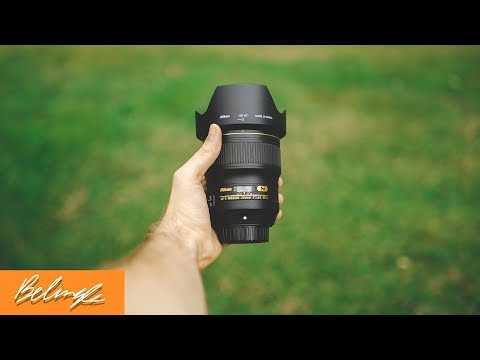
Nikon 28mm: Обзор Nikon 28mm F1.8G | Радожива
Flare and Chromatic Aberration
Actually, chromatic aberration or color fringing is not an issue for me, as most raw conversions can easily handle this with one click. The Nikon 28mm f/1.8G has chromatic aberration, like many other lenses, especially on the edges when used with wide apertures, but it is acceptable and easy to remove in postproduction. However, even though it has Nano Crystal Coating, I noticed a slight flare on some images when shooting against direct sunlight. Again, it is normal in those circumstances. On the other hand, when shooting a shiny night scene, or a scene with a reflected harsh sun light, I didn’t notice any flare.
Тема: Выбор ширика
Автор реплики: tak_nada
Пользую Никкор 28мм ф1.8Г который новый
безумно резкий даже на открытой, в связи с наличием нанопокрытия не ловит художественных бликов (как например 35мм ф2) — не знаю с одной стороны это плюс, с другой минус
самый главный недостаток (на кропе опять же) — в видоискатель не видно попал ли в фокус на групповых портретах и открытой диафрагме… ![]()
Фокусировка тихая, объектив легкий…)
у меня на кропе был сначала 50мм (казался телевиком) — потом 85 (казался супер телевиком) — взял 35 (показался широким) взял 28 — вообще суперширик прям кажется.
токина 12-24 вообще без дела лежит..
Conclusion
The Nikon 28mm f/1.8G is an everyday carry-around lens that you can use for street, wedding, stock, and landscape photography. I wouldn’t recommend this for architectural photography like it is stated on Nikon’s website, because even though the barrel distortion is acceptable and easy to fix in post-processing, I would recommend tilt-shift lenses to get better images for architectural photography. Besides, Nikon DX format users would rather consider the Nikon AF-S DX 35mm f/1.8G, which is 52.5mm in focal length (35mm equivalent) and more affordable with a price tag of $196.95. On the other hand, Nikon FX users should definitely have this lens in their bag. If you buy it from B&H, a Luminosque Circular Polarizer and UV Slim Pro filter kit is included for free in the total $696.96 price tag.
Beyond any doubt, 28mm lenses are one of the most underrated lenses in wide-angle primes. Because they are not as wide as 20mm or 24mm lenses, users usually don’t prefer this focal length in order to have wider angle options. However, 28mm is a unique, sweet-spot focal length that would give you stunning results, and with the Nikon 28mm f/1.8G Nano, you can achieve good results in an affordable way.
Build Quality
It has a plastic barrel with a metal mount like many other lenses within the same price range. I cannot say it is a perfectly built robust lens, but at this price point, I was aware that I couldn’t have expected the same build quality that high-end Nikkor lenses have. Also, I can clearly say that even some third-party lenses have better overall build quality. To be honest, if you handle your gear with care, then there is nothing to worry about. But in terms of being a top-notch brand, I’d have expected better from Nikon.
I couldn’t see any information about weather-sealing features with this lens on Nikon’s website, however at first sight, it looks like it is definitely not waterproof. As it is a prime lens with rear focusing elements, it doesn’t have any rotating external elements, therefore it doesn’t have the same risk to suck dust inside like zoom lenses do. I didn’t have a chance to test this lens under drizzle, but in any circumstance, it is always better to keep your lens away from water. Also keeping little silica gel sachets in your lens pouch will help to prevent humidity and fungus.





















